Friday, June 09, 2006
Æ29, Tyre in Phoenicia, Gallienus, ...
cf. Lindgren & Kovacs 2396 (Valerian)
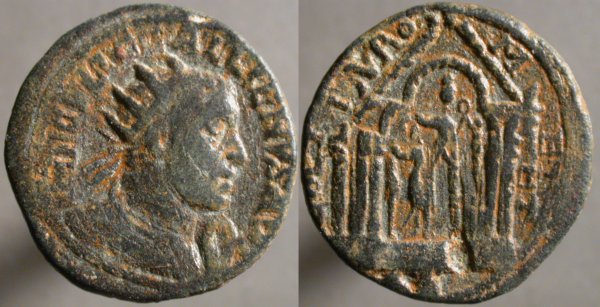
[IMP C P] LIC GALLIENVS AV, Radiate draped cuirassed bust right | COL TVRO M_ET, Hexastyle temple containing statue of Astarte, right hand on trophy, crowned by Nike standing on column at right. In front of temple altar, murex shell before and palm tree at right.
The imperial coins such as those I feature on Mondays and Thursdays are well-documented in a few multi-volume sets, such as Roman Imperial Coins and the Austrian-published Moneta Imperii Romani.
Minted by hundreds of cities across the empire, though, provincial coins such as today's post, have no comprehensive single reference (and perhaps never will.) The Roman Provincial Coinage, which attempts to be comprehensive, has begun to be published, but it has many volumes to go. Provincials are cataloged in a few overview volumes, such as David R. Sear's Greek Imperial Coinage or as continuations of Greek coinage in books cataloging a single collection, such as Sylloge Nummorum GraecorumL Copenhagen: The Royal Collection of Coins and Medals Danish National Museum, or those covering the coins of a single city, such as David MacDonald's The Coinage of Aphrodisias..
As Ed Snible mentioned in a recent post on A Gift For Polydektes, numismatic books have high prices and small print runs. They also frequently aren't reprinted, or are reprinted only after many years.
As the W.H. Waddington, E. Babelon, Th. Reinach collaboration Recueil Général des Monnaies Grecques d'Asia Mineure came up, to my advantage, in the comments to Tuesday's post, I'll here mention that book as a sad example of a failed attempt at a comprehensive catalog of Greek-language coins of Asia Minor, begun in 1904, and ended only partly done, in 1912. I think the 1st World War and events preceding it made it impossible to continue.
As far as they got, though, it is very useful.
Even after you've found books while they're available, and paid a high price for them, you still may have coins that are published only in other books.
I have no catalog reference for this rather busy-looking coin from Tyre of Gallienus but do have a reference to a similar reverse on a coin of his father, probably minted at the same time as this.

[IMP C P] LIC GALLIENVS AV, Radiate draped cuirassed bust right | COL TVRO M_ET, Hexastyle temple containing statue of Astarte, right hand on trophy, crowned by Nike standing on column at right. In front of temple altar, murex shell before and palm tree at right.
The imperial coins such as those I feature on Mondays and Thursdays are well-documented in a few multi-volume sets, such as Roman Imperial Coins and the Austrian-published Moneta Imperii Romani.
Minted by hundreds of cities across the empire, though, provincial coins such as today's post, have no comprehensive single reference (and perhaps never will.) The Roman Provincial Coinage, which attempts to be comprehensive, has begun to be published, but it has many volumes to go. Provincials are cataloged in a few overview volumes, such as David R. Sear's Greek Imperial Coinage or as continuations of Greek coinage in books cataloging a single collection, such as Sylloge Nummorum GraecorumL Copenhagen: The Royal Collection of Coins and Medals Danish National Museum, or those covering the coins of a single city, such as David MacDonald's The Coinage of Aphrodisias..
As Ed Snible mentioned in a recent post on A Gift For Polydektes, numismatic books have high prices and small print runs. They also frequently aren't reprinted, or are reprinted only after many years.
As the W.H. Waddington, E. Babelon, Th. Reinach collaboration Recueil Général des Monnaies Grecques d'Asia Mineure came up, to my advantage, in the comments to Tuesday's post, I'll here mention that book as a sad example of a failed attempt at a comprehensive catalog of Greek-language coins of Asia Minor, begun in 1904, and ended only partly done, in 1912. I think the 1st World War and events preceding it made it impossible to continue.
As far as they got, though, it is very useful.
Even after you've found books while they're available, and paid a high price for them, you still may have coins that are published only in other books.
I have no catalog reference for this rather busy-looking coin from Tyre of Gallienus but do have a reference to a similar reverse on a coin of his father, probably minted at the same time as this.
Thursday, June 08, 2006
Silvered Æ antoninianus, Gallienus, Rome, Göbl 750b
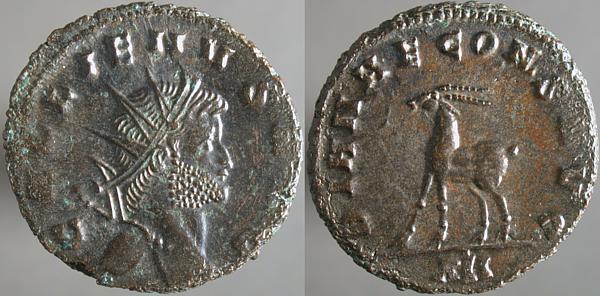
GALLIENVS AVG, Radiate head right | DIANAE CONS AVG, Gazelle walking left. XII in exergue.
Toward the end of his reign an unusual series of coins were minted at Rome for Gallienus and Salonina, unvoking the protection of the gods. Each featured an animal, real or mythological, associated with a god or goddess. The best treatment of this series is here.
Wednesday, June 07, 2006
Æ3/4, Constantine II, Siscia, LRBC I,748
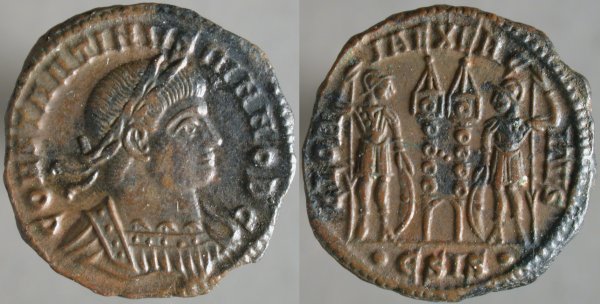
CONSTANTINVS IVN NOB C, Laureate cuirassed bust right | GLORIA EXERCITVS, Two soldiers standing either side of two standards, ·CSIS· in exergue.
Flavius Claudius Constantinus was the eldest son of Constantine I and Fausta and became emperor, as did his brothers, in 337 after their father's death.
Constantine II was also the first son of Constantine I and Fausta to die, meeting his end in 340 at the head of an army he was leading against his brother Constans.
Tuesday, June 06, 2006
Æ25, Nicaea in Bithynia, Valerian, ...
Recueil Général des Monnaies Grecques d'Asia Mineure, p500, 793
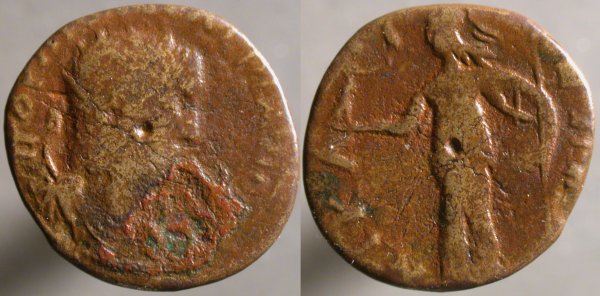
ΠOY [...]ΛEPIANO[...], Radiate draped cuirassed bust right | NIKA_I_EΩN, Athena standing left holding Nike on right hand, sheild and spear with right.
I don't know that this coin has any virtues but rarity and that I didn't have an example of it. With the legends partly off the flan and badly worn, it's difficult to read clearly. The area in front of the lower face adds a distasteful quality.
Updated: Thanks to Ed Snible who pointed me to a correct catalog entry in the comments.

ΠOY [...]ΛEPIANO[...], Radiate draped cuirassed bust right | NIKA_I_EΩN, Athena standing left holding Nike on right hand, sheild and spear with right.
I don't know that this coin has any virtues but rarity and that I didn't have an example of it. With the legends partly off the flan and badly worn, it's difficult to read clearly. The area in front of the lower face adds a distasteful quality.
Updated: Thanks to Ed Snible who pointed me to a correct catalog entry in the comments.
Monday, June 05, 2006
Billon antoninianus, Salonina, Antioch, Göbl 1576h
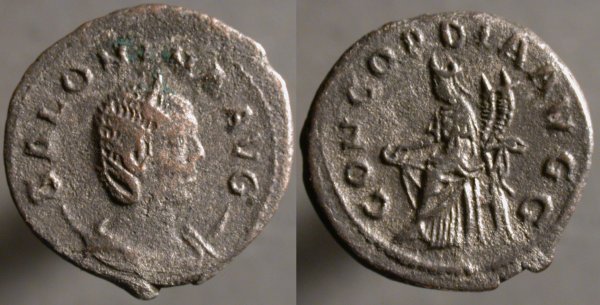
SALONINA AVG, Diademed draped bust right on crescent | CONCORDIA AVGG, Concordia seated left, holding patera in right hand and cornucopia with left.
There was a significant change in the appearance of coins from Antioch which may well coincide with Shapur's conquest of the city, the date of which remains disputed. Even if not related to this conquest, then the dies of the later coins were engraved by a different hand for some other reason.

